What does your bloodstream and nail polish remover have in common? Both contain a ketone body called acetone. It sounds like a poorly written joke, but it’s merely a little-known fact about the human body.
Acetone is the smallest ketone, which is produced naturally in our bodies as we are entering and sustaining a ketone-burning state called ketosis. Although acetone can be poisonous when inhaled or ingested, it is harmless (and may even be helpful) when it is produced within our bodies.
How is this possible? Let’s take a closer look at acetone to find out.
What Is Acetone?
Acetone, systematically named propanone, is the simplest and smallest ketone. (Not sure what a ketone is? Read through this article if you’d like to find out.)
Although it is naturally found in plants, animals, the environment, and our bodies, acetone is almost exclusively known as the active ingredient in nail polish, paint thinner, and other industrial products.
Acetone is so widely used because it serves as a solvent that dissolves other liquids highly effectively. This is why nail polish remover can swab a manicure right off your nails. While this colorless liquid might look harmless in the store, acetone is not something that you can take lightly. It is highly flammable and can be very toxic when inhaled and consumed.
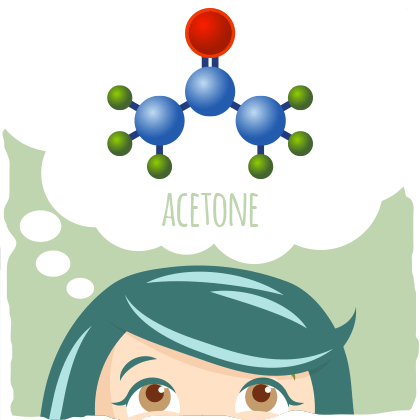
In other words, acetone is a versatile solvent, but it is only safe for our bodies when it is produced internally and released out into the environment. If acetone goes in the opposite direction, from external sources into our bodies, then it will cause minor to severe health problems.
Acetone from the Outside in — External Exposure and Safety Concerns
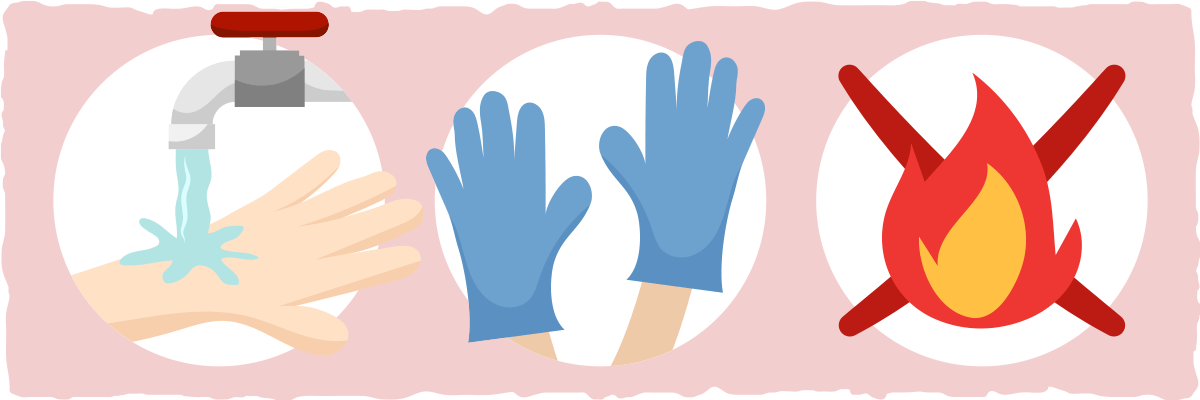
Acetone that isn’t produced by your own body is considered a toxic and volatile organic compound. Therefore, it’s crucial to practice chemical safety when dealing with acetone.
Health effects of acetone exposure (via consumption or inhalation) are usually mild, the most common symptoms being lethargy, headache, slurred speech, and lack of coordination. Topical exposure to acetone will only irritate the area that comes in contact with it, while repeated exposure could cause dermatitis.
High levels of acetone exposure, however, may lead to more severe symptoms that can be life-threatening.
To treat acetone poisoning due to high levels of acetone exposure, a medical professional will usually give the body time to exhale it out of the lungs (the primary route of acetone excretion) while maintaining the patient’s vitals and fluid levels. On the other hand, If acetone comes into contact with your skin or eyes, it is best to remove any contaminated clothing and flush the area with water.
Preventing acetone poisoning is intuitive and straightforward. Wearing protective gloves and clothing and keeping the space ventilated is best. And, of course, don’t consume acetone.
It’s also important to keep it away from open flames or other ignition sources, as acetone can catch fire when exposed to temperatures above its flash point. The vapor from acetone can travel to distant ignition sources as well, so its best to follow strict guidelines when using this compound.
To protect workers who work with acetone, the Occupational Safety and Health Administration (OSHA) of both the United States and Canada set “threshold limit values” for acetone. This is essentially an “exposure limit” to how much acetone workers can come into contact with over their lifetime without adverse health effects. (If you have any questions regarding the safety guidelines, feel free to check out the relevant sources at the end of this article.)
In summary, it is best to keep acetone off of your skin, out of your lungs, outside of your body, and away from fire and other ignition sources. Fortunately, the same considerations don’t need to be taken when these ketones are produced endogenously (inside the body). Our bodies are able to regulate our natural acetone levels so that they are excreted without causing any harm to the body (in most cases).
Acetone from the Inside Out — Production and Excretion
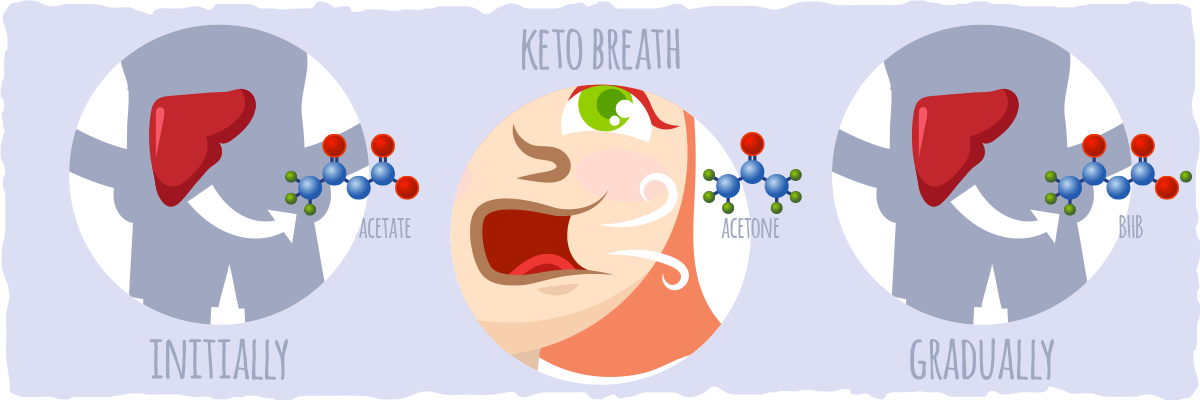
All of us have acetone in our bodies due to the conversion of body fat (and some amino acids) to ketones via a process called ketogenesis. During this process, the liver converts fatty acids into ketone bodies that other cells throughout our body, particularly our brain, heart, and muscle cells, can use as an efficient fuel source when carb and/or calorie consumption is limited.
When the liver first starts producing ketones for fuel, the process isn’t as efficient as it could be. Due to the relative lack of energy substrates and ketone producing enzymes, it is much less likely that the most efficient ketone body, beta-hydroxybutyrate (BHB), will be created when you first begin keto dieting or fasting. Instead, another ketone called acetoacetate is produced in higher quantities and sent off into our circulation to be used by our other tissues.
Although this ketone body will serve as an efficient energy alternative for sugar, acetoacetate can also be spontaneously converted into acetone. Once this happens, the acetone becomes virtually useless and travels through the body until it is excreted in our breath, urine, and sweat. Unfortunately, this causes us to have what many call “keto breath,” the not so pleasant smell of faint nail polish or overripe fruit coming out with each exhale.
As the body’s need for ketones increases, the conditions in the liver will favor BHB production more than acetoacetate production, and BHB will become the most prevalent ketone in the body. Once this happens, circulating acetone levels may decrease, and keto breath will no longer be a problem.
Stated more simply, acetone is just a byproduct of reaching and maintaining ketosis, and it is mostly excreted through your breath. This is only time when having bad breath is a good thing because it indicates that you are on track to achieving and maintaining ketosis (if that is your goal).
Acetone from the Inside Out — Safety Concerns
The only time that acetone production can be harmful is when the body’s natural ketone regulating mechanisms are not working correctly. Without the proper regulatory mechanisms in place, ketone levels will continue to rise in the presence of uncontrolled blood sugar levels (or alcohol levels), and the body will eventually enter an unhealthy and potentially life-threatening state called ketoacidosis.
This will almost always occur as a result of uncontrolled diabetes (more likely for people with type 1 diabetes), a combination of excessive stress and calorie restriction, or excessive alcohol consumption. For an in-depth explanation of ketoacidosis and how to prevent it, check out our guide to ketoacidosis.
In contrast to ketoacidosis, nutritional ketosis that is induced by a keto diet or intermittent fasting is a safe and healthy metabolic state.
In fact, you can experience a variety of health benefits by increasing your ketone production in a healthy way. (If you would like to learn more about nutritional ketosis before continuing on, I recommend reading through our guide to ketosis.)
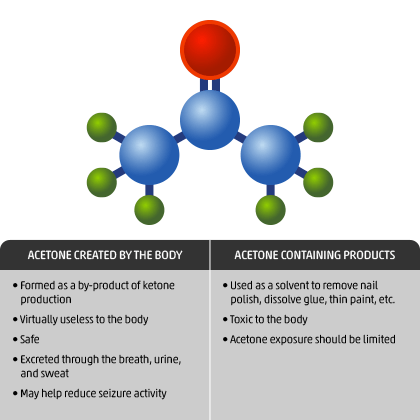
What Acetone Means for the Keto Diet — One Clear Sign That You Are Doing Things Right
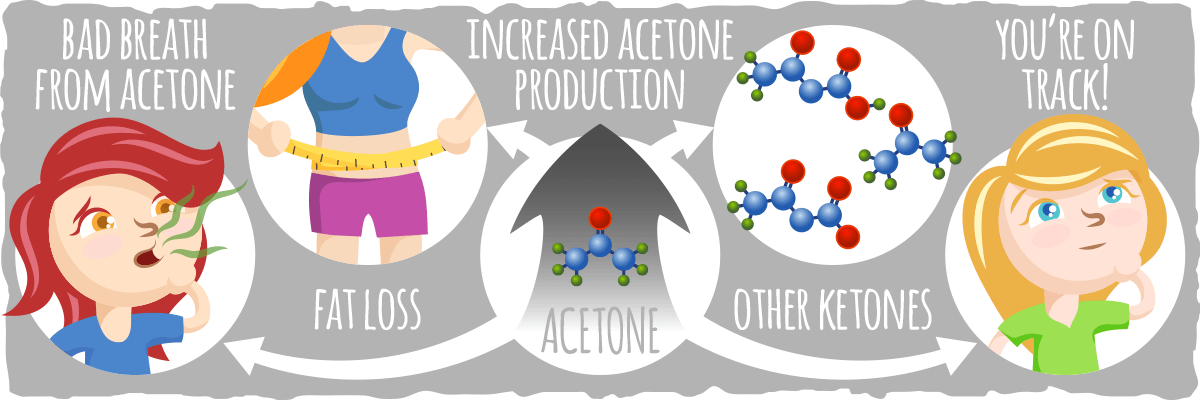
When your body starts producing more acetone than usual, this provides you with evidence that you are in (or about to be in) ketosis.
In fact, studies indicate that breath acetone levels correlate with plasma levels of all three ketone bodies. In other words, keto breath is one of the most reliable signs that you are in ketosis.
Although acetone is relatively useless to the body, it does let you know that you are producing more ketones — and if your body is increasing its ketone production that means you will soon experience all of the benefits of the ketogenic diet.
A Brief Overview of the Benefits of Ketosis and Keto Dieting

The keto diet focuses on restricting carbs in a way that shifts our bodies into nutritional ketosis. This combination of sustained ketosis and cutting carbs has been found to provide us with a plethora of benefits including:
- Enhanced brain health and cognitive function
- Increased energy
- Decreased pain and inflammation
- Improved body composition (fat loss and breath acetone concentration are strongly correlated)
- Reduced appetite
- Improved exercise performance and endurance
This explains why the ketogenic diet has been found to help individuals with these conditions:
- Epilepsy
- Type 2 Diabetes
- Type 1 Diabetes
- High Blood Pressure
- Alzheimer’s disease
- Parkinson’s disease
- Chronic Inflammation
- High Blood Sugar Levels
- Obesity
- Heart Disease
- Hyperlipidemia
- Polycystic Ovary Syndrome
- Fatty Liver Disease
- Cancer
- Migraines
Each condition can be helped in some way by following a keto diet and burning ketones for fuel — and increased acetone excretion serves as one of the first indicators that you will relish in these amazing results. Incredible, right?
If you’d like to take a closer look at the research behind these claims, check out our article on the benefits of the ketogenic diet.
Acetone May Be Helpful as Well
As I was researching the benefits of ketones, I came across a couple of studies suggesting that acetone isn’t such a useless by-product after all.
In the literature that explored the effects that the keto diet and ketones have on seizure activity, animal studies discovered that acetone has antiseizure potential that is not related to the use of ketones for fuel. Although this finding hasn’t been tested in humans, the results do suggest that acetone has therapeutic potential for those who are prone to seizures.
How to Test for Acetone (and the Other Ketones)
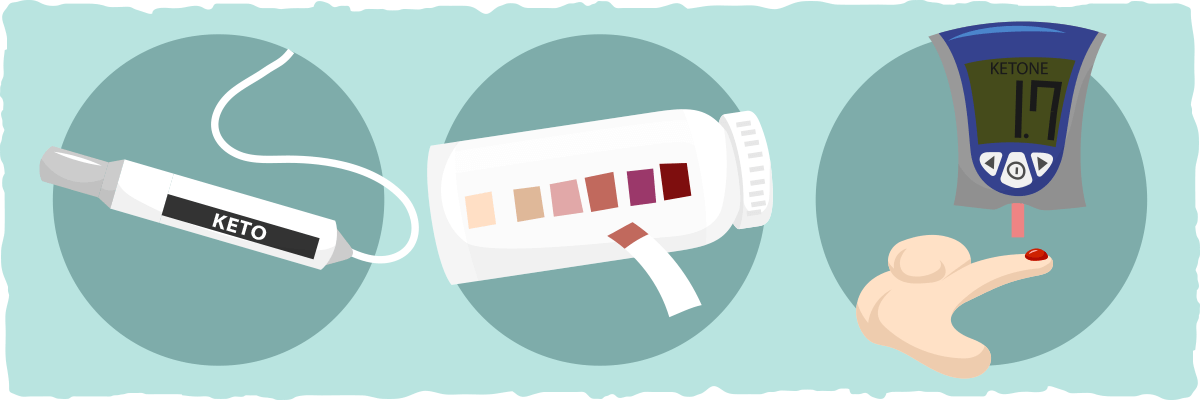
Knowing the nature of how acetone is excreted from the body (primarily through the breath), we can use this understanding to figure out if we are in ketosis (or, at least, on the right track with our diet).
A ketone breath measuring device, like the Ketonix meter, is the best way to use your newfound knowledge of acetone to see if you are in ketosis. It might seem pricey initially to buy a breath meter, but the benefit is that you’re able to use it forever.
Don’t forget, however, that your acetone levels only serve as an estimate as to how much acetoacetate and BHB, the only ketones that your cells can use for energy, are circulating through your blood.
If you would rather not invest in a breath meter, there are two other methods that track the presence of the other two ketones in your body as well.
The first method is using ketone urine sticks. By simply peeing on one of these sticks, you can get a relative estimate of how much acetoacetate you are producing.
The second ketone measuring device is a blood ketone meter. This device tracks your BHB levels precisely without any guesswork (unlike the other two measuring methods). The only downsides of using the blood ketone meter are that you have to draw blood and spend extra money on the test strips (which will get very expensive if you want to track your ketone levels diligently).
If you’d like to take a closer look at each one of these ketone measuring methods, check out our guide to measuring ketosis. You will find the answer to most of your ketone measuring questions there.
Key Takeaways — What You Need to Know about Acetone
Acetone is a naturally produced ketone body that is toxic when inhaled, consumed, or exposed to the skin, yet completely safe when it is produced in the body (unless the person is vulnerable to ketoacidosis).
Although it is relatively useless to the body and excreted through the breath almost immediately, acetone levels serve as an indirect indicator that we are producing the other two ketones that actually provide us with energy.
In other words, once you get keto breath (due to increased acetone excretion), what will come next — if you keep following the keto diet — is a multitude of benefits that can only be experienced when you burn ketones and restrict carbs.
Sources:
- Acetone — CDC
- Acetone — CCOHS
- What Are Ketones? Everything You Need to Know — Ruled.me
- Regulation of Ketone Body Metabolism and the Role of PPARα — NCBI
- Do ketogenic diets really suppress appetite? A systematic review and meta-analysis. — NCBI
- Ketone Bodies in Epilepsy — NCBI
- Malonyl-CoA: the regulator of fatty acid synthesis and oxidation — NCBI
- Ketosis as a treatment for multiple metabolic and neurodegenerative pathologies — Journal of Translational Science
- Anticonvulsant properties of acetone, a brain ketone elevated by the ketogenic diet. — NCBI
- Measuring breath acetone for monitoring fat loss: Review — NCBI
- Effect of weight loss and ketosis on postprandial cholecystokinin and free fatty acid concentrations. — NCBI
- Beyond weight loss: a review of the therapeutic uses of very-low-carbohydrate (ketogenic) diets. — NCBI
